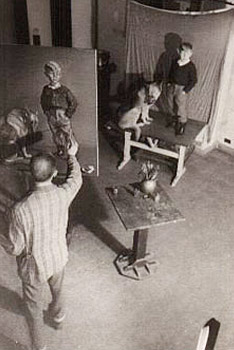 |
|
| BIOGRAFÍA |
ÓLEO |
 |
 |
 |
||
| Biografía | 4/5 | |||
 |
||||
 At his study of Buenos Aires, portraying his son, 1958 |
In the more private sphere, thanks to his investigation into the processes of representation and the capturing of reality (not only in oil painting, but also in his renewed study of drawing, which focused almost exclusively on the human body) he was obtaining results which regularly aroused admiration, and also uneasiness. Eufemiano went on to study the history of Western plastic arts critically, and humbly understood himself and his projects in relation to the giants who had preceded him. At the same time his search in the field of composition was reaching new levels of essentiality, in which poor and simple objects of everyday life, or from the recent past, and basic materials – wood, tin, fabrics, ceramic, food – emerged as absolute protagonists of the work of art, as “characters worthy of a portrait”, on self-contradicting backgrounds (devoid of direct semantic content, but, at the same time, carefully constructed in shade and volume). Or rather a plurality of portraits, since until the very end of his career various thematic series would emerge in his work in which he “repeated without repeating” the same argument, enriching and renewing it. Thus, Eufemiano, an emigrant in his own native land, a pioneer of the avant-garde use of the grammars of the great classical painting, a portrait-painter of the inanimate reality, was fulfilling the ambitious project formulated nearly thirty years earlier, in Seville, at the start of his career. Outside, in the surrounding world, “new realism”, under various imperfect names (hyper-realism, magic realism), was becoming widely accepted, thus making it possible for more conformist views, which unfortunately were prevalent in cultural policy, to accept the public presence of these movements. |
|||
| Versión española | 4/5 | |||
| Gerencia del Legado Artístico Bendición de Campos 10, 28036 Madrid, España T: +34 609 30 32 38 · info@eufemiano.org |
|